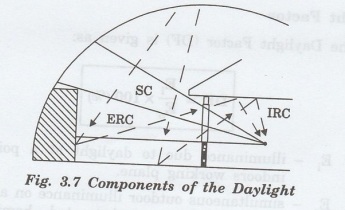Physics For Civil Engineering: Unit III: Acoustics and Lighting Designs
Daylight Calculations
Daylight Factor Formula
DAY LIGHT CALCULATIONS The amount of daylight received into an indoor space or room is defined as a daylight factor. It is the ratio between the measured internal and external light levels.
DAY LIGHT CALCULATIONS
The
amount of daylight received into an indoor space or room is defined as a
daylight factor. It is the ratio between the measured internal and external
light levels.
Daylight
Factor
The
Daylight Factor (DF) is given as:

where
E1 - illuminance due to daylight at a point on the indoors working
plane.
E0
- simultaneous outdoor illuminance on a horizontal plane from an
unobstructed hemisphere of overcast sky
There
are three possible paths along which light can reach a point inside a room
through glazed windows (Figure 3.7).
They
are:
(a) Sky Component (SC): Light from
visible at the point considered.
(b)
Externally Reflected
Component (ERC): Light reflected from opposing exterior
surfaces and then reached the point.
(c)
Internally Reflected Component (IRC): Light entering through
the window but reaching the point only after reflection from internal surfaces.
The
day light can reduce the usage of artificial lighting. This process is known as
daylight harvesting.
In
recent years, work has taken to recreate the effects of daylight artificially.
This
is however expensive in terms of both equipment and energy consumption. It is
applied in specialist areas such as film making.
The
sum of the three components gives the illuminance level (Lux) at the point
considered as
LUX
SC + ERC + IRC

Daylight
factor is used in building design in order to assess the natural lighting level
as received on the working plane.
Physics For Civil Engineering: Unit III: Acoustics and Lighting Designs : Tag: : Daylight Factor Formula - Daylight Calculations
Related Topics
Related Subjects
Physics for Civil Engineering
PH3201 2021 Regulation | 2nd Semester Civil Dept 2021 Regulation
